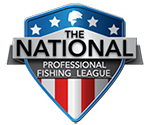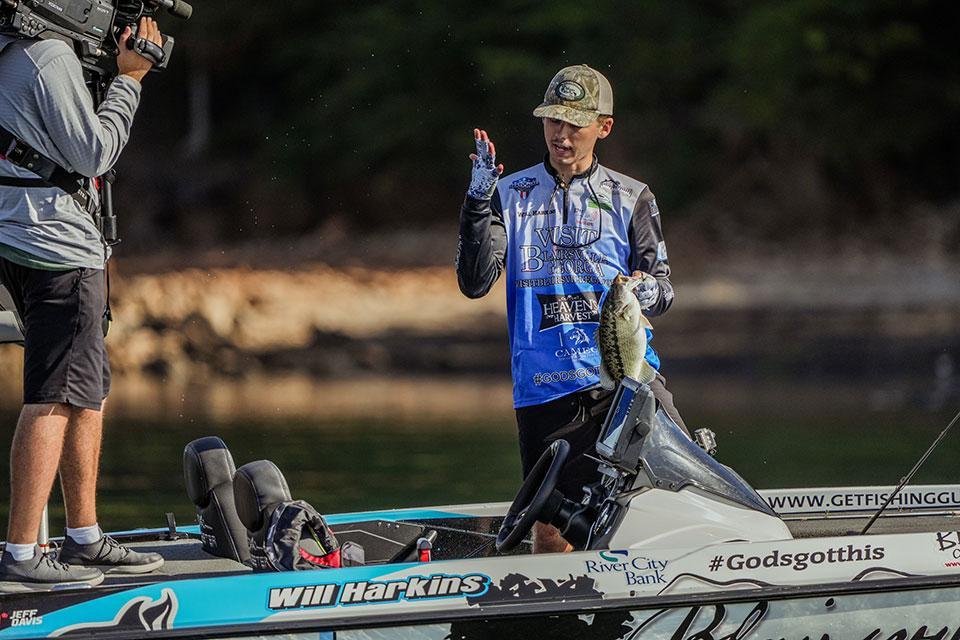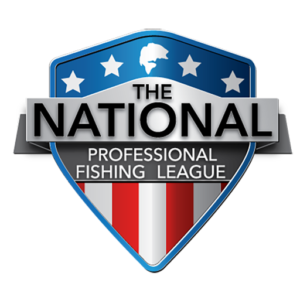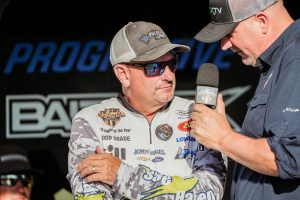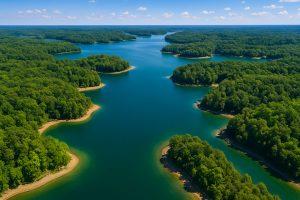Story by Ken Duke featuring Will Harkins | Photos by Tanner & Travis Lyons
Hometown: Blairsville, Georgia
Technique: Drop shotting the shallows
History: Drop shotting came out of Japan about 25 years ago and may be the most bite-getting technique among professional tournament anglers. As good as it is and as popular as it is, it may still be underrated. The drop shot not only catches numbers of bass; it also catches big bass…when you put it in front of one. I got into drop shotting by reading and hearing about it and then by watching how-to videos with Aaron Martens explaining his methods. Since then, I’ve added a few tweaks of my own and made it my go-to. I have a drop shot rod on the deck of my boat every day I’m on the water.
Highlights: In 2023 I finished third at Santee Cooper and put over 55 pounds on the scales over three days—all on a drop shot—to get my first NPFL check. I can’t remember a tournament when I didn’t catch at least one bass on a drop shot, including my win at Logan Martin earlier this year.
When: Always! But especially in the fall, when the water temperature is between about 50 and 62 degrees. That seems to be when a lot of bass move deep and lots of others—including some big ones—move shallow. I like to target isolated rock in the shallows for big bass at this time.
Where: As lakes turn over in fall, dissolved oxygen concentrations are typically better in the shallows, causing lots of big fish to move into 5 to 12 feet of water. This is especially true on midland and highland impoundments. It’s the perfect time and depth to go “shallow scoping,” but you don’t need forward-facing sonar to make this method work. I target isolated rock. When I find it under these conditions, I’ve usually located some good fish, though the fish I find are often singles and rarely grouped up.
Lures: Ninety-five percent of the time, I use a Straight Tail Roboworm when drop shotting. I like the 4.5-inch on waters with a lot of spotted bass and the 6-inch around largemouths. I carry three colors: Prism Shad (for super clear water), Red Craw (when I want a crayfish imitation), and Green Pumpkin (for every other situation). I rig it on a 1/0 Roboworm Rebarb Hook and a 3/16-ounce Ark Tungsten Drop Shot Weight for depths down to 10 feet. Deeper than that, I go to a 1/4-ounce weight. I always use the lightest weight I think I can get away with. My leader between the bait and the sinker is usually about 10 inches—longer in extremely clear water and shorter if there’s some brush in the area.
Mods: Sometimes I’ll wacky rig the Roboworm to mix things up and give the bass a different look.
Line: For the main line on my reel, I use 15-pound-test Berkley X5 braid in Crystal (it’s easy to see). My leader is Berkley Trilene 100% Fluorocarbon—10-pound-test for rocky bottoms and 8-pound for soft bottoms.
Rod: 6-foot-10 medium-light Ark Invoker Tour Series spinning rod
Reel: Ark Gravity GS5 spinning reel
Basics: When I’m drop shotting and shallow scoping, I usually lay off my target area by 80 to 100 feet and make a long cast to it. If I can see the fish on my electronics and it appears to be active, I’ll shake the bait a little and then let it sit still. If the fish are not acting anxious around the bait, I’ll hold my rod tip up at about the 10 o’clock angle and slowly reel the bait in, making sure it maintains bottom contact. If you’re not looking at fish on your electronics, fish the bait with little shakes and hops, but don’t overwork it. You want to keep it on the bottom at all times so you can feel every piece of cover. If your sinker bumps into something, stop and soak the bait there a while. That’s a high percentage area to get a bite.
Advanced: Drop shotting is a way to get a lot of bites, but that doesn’t mean it’s a small fish technique. It catches big bass, too. Use it more often, take it shallow and stick with it. It’ll pay off!
Will Harkins – Angler Profile
